ISSN ONLINE(2278-8875) PRINT (2320-3765)
ISSN ONLINE(2278-8875) PRINT (2320-3765)
Rahul Yadav1
|
| Related article at Pubmed, Scholar Google |
Visit for more related articles at International Journal of Advanced Research in Electrical, Electronics and Instrumentation Engineering
The paper presents design and optimization of helical antenna to resonate multiple bands. Special impedance matching rectangular cavity has been designed which backs the helical antenna so that electric field vector can be confined. The antenna is operating in the frequency range of 5-16 GHz. The antenna has a peak gain of 9.61 dB and a maximum of six resonant bands. Computer simulation tool is used in the designing.
Keywords |
| Cavity, Diameter variation, Multiple bands, Conformal shape. |
INTRODUCTION |
| In today’s communication world there need to find ways to improve existing designs or introduce novel designs in order to achieve desirable radiation characteristics, reduction in size, weight and thus making the antenna more cost effective. Gain, bandwidth and axial ratio are some of the important properties on which improvement is desired. Compact size and weight may be a mandatory requirement for antennas used in spacecraft, aircrafts and satellite communication. Helical antenna which has always been in demand for wireless communication due to its ease of implementation, availability of high gain and circular polarization. It’s not therefore surprising that a wide range of application exist, ranging from military surveillance, numerous commercial and private uses, including the consolidation of multiple antennas working in ISM band. Various approached has been presented in [1]-[4] to enhance the antenna radiation characteristics. |
| In this paper a conformal and compact cavity backed 1½ turn helical antenna has been designed. The behaviours of helix inside the designed cavity is investigated by varying the diameter of the helical antenna. The variation in helix diameter changes the spacing of helix with respect to the cavity wall and thereby helps to excite various resonant bands. |
ANTENNA DESIGN |
| Initially a rectangular cavity has been designed which backs the helical antenna. The cavity has length and width of 24*24mm and a height of 22mm. The geometry of rectangular cavity is shown in Fig.1. |
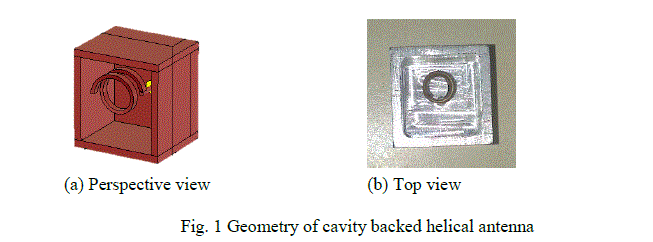 |
| A 1½ turn helical antenna is loaded inside the cavity. The turns of helix are kept low to provide compact geometry and also these odd no. of turn will provide odd symmetry with respect to the wall and thus it will help to resonate various bands. To excite more number of resonant bands, the helical antenna diameter is varied inside the cavity. Fig.2 shows the variation of helix diameter. The diameter is subjected to an incremental step size of 2mm to investigate the complete behaviour of helicalantenna inside the cavity. The feed location is shifted accordingly in order to accommodate the helix well within the cavity, otherwise the helix may coincide with the cavity walls with its feed location at the center of the ground plane. |
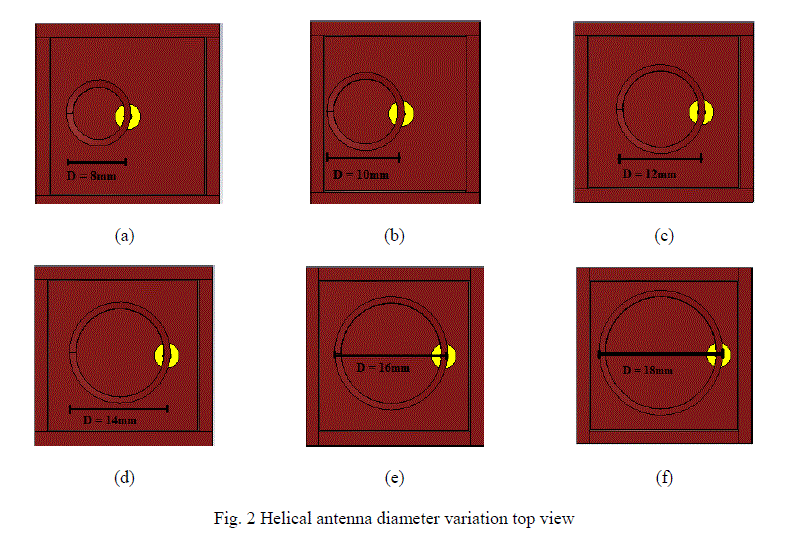 |
RESULTS AND DISCUSSION |
| The analysis begins with the comparative plot of reflection coefficient as shown in Fig. 3 for diameter variation performed on the helical antenna inside the rectangular cavity. |
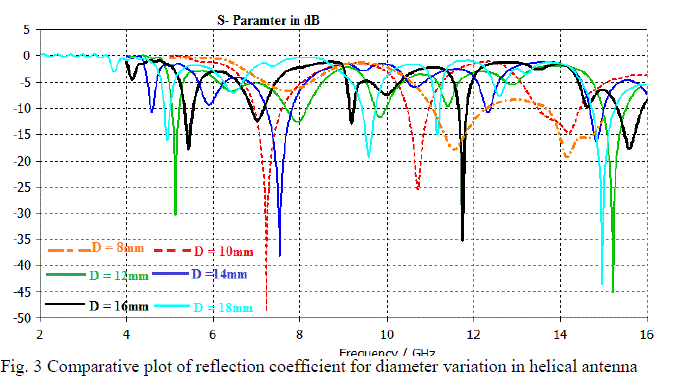 |
| In Fig.2 it can be clearly seen that the spacing between the helical antenna and the cavity wall is varying as the diameter increases. It is found that as the spacing between the cavity walls and helix is reduced, there is more number of reflections from the walls. It is observed that the frequency bands are resonated towards lower frequency in the decreasing manner of diameter from 18mm to 8mm. This justifies a simple inverse relation of frequency and wavelength. Since for diameter equal to 18mm the physical dimension of the antenna is highest, this eventually increases the range of frequency band where in case of diameter of 8mm the first resonating band is excited in the end compared to other diameters.Table 1 shown the complete analysis of helix diameter variation. |
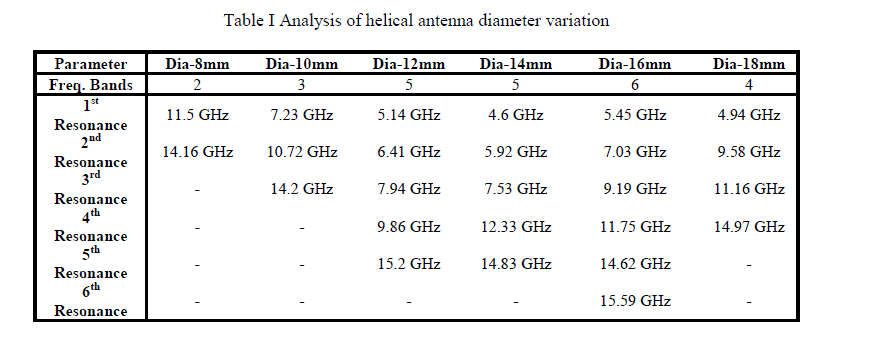 |
| From the analysis of helix diameter variation represented in Table 1, it is found that for diameter equal to 8mm and 10mm the spacing between the walls of the cavity and the helix is more which excites only two and three frequency bands respectively. Whereas in case with helix diameter equal to 12mm and 14mm , the parameter spacing eventually increase resulting in five frequency bands and lastly with diameter of 16mm the spacing is very less and uniform from all the sides of the walls and thereby causing more frequency bands to resonate. But this not the case in diameter of 18mm. |
| Now the gain analysis is also done by performing a comparative analysis as shown in Fig. 4. |
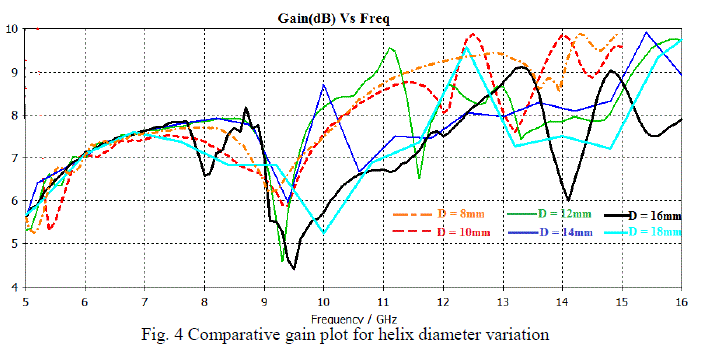 |
| A wideband gain for all the variation in the diameter of the helical antenna is observed between 4dB to 10 dB ranging from 5GHz to 16GHz. For the helix dia-8mm, the peak gain is 9.87dB at 14.3GHz whereas in case of dia-10mm the peak gain is again 9.84 dB but at 12.49 GHz, for dia-12mm a peak gain of 9.53 dB is observed at 11.12 GHz and dia- 14mm, 16mm, 18mm has a peak gain of 8.69 dB, 9.12dB, 10.16 dB at 10 GHz, 13.3GHz, 16.38GHz respectively. |
CONCLUSION |
| The designed antenna exhibits multiple resonant bands and thus support various microwave range of frequencies. It is found that the parameter spacing plays important role in excitation of various resonant bands. The antenna being compact and conformal is suitable to use for WLAN, personal wireless communication, spacecraft etc. There still vast scope in optimizing the antenna geometry to achieving enhanced radiation characteristics. The future work will be to develop array of various types of cavity for gain enhancement. |
References |
|